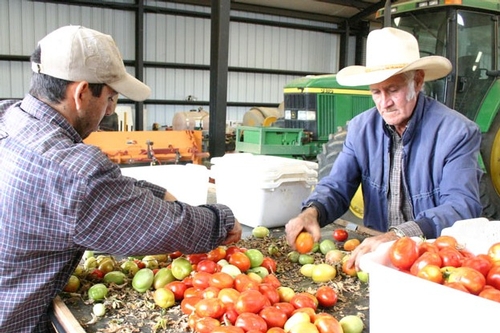Posts Tagged: Russell Ranch
UC Davis tomatoes provide year-round healthful eating for college students
At the same time, chefs and food buyers at universities, particularly the University of California, are selecting for high-quality fruits and vegetables, produced locally and sustainably. Universities with strong food sustainability programs are rightfully proud of what they're doing to educate students about food production, health, and nutrition. UC Davis Dining Services prioritizes the purchase of locally grown food (ideally within a 50-mile radius of campus). Most University of California campuses have similar programs.
At UC Davis, fresh roma tomatoes are picked each August from the 300-acre Russell Ranch, part of the campus's Agricultural Sustainability Institute, then processed within hours by campus Dining Services to provide year-round tomato sauce for pizza, pasta, and ratatouille. All told, 10,000 pounds of tomatoes are processed during a two-week period in August. About 29 percent of the total food served in the campus's residential dining halls is from local, organic or sustainable sources.
The tomatoes grown at Russell Ranch are part of a long-term academic research project that examines factors such as farming methods, irrigation needs, crop rotations, yield, and nutritional content. At the end of the growing season, some of the many tons of tomatoes are purchased by Dining Services at market value.
Emma Torbert, an academic coordinator at the UC Davis Agricultural Sustainability Institute, noted, “Connecting the food system to the research is really interesting. A lot of times there is confusion about where our food is coming from. The more people are educated, the more educated decisions they can make.”
Many UC Davis faculty and staff are so impressed with the food choices at the dorms that they purchase individual meal tickets and enjoy lunches made with the campus-grown tomatoes, herbs, and other vegetables, all of which are part of the daily food array. Public dinners are also offered periodically at the dorms so that community members can sit amongst students to taste and learn about the sustainability programs in the dorms.
Additional Information:
- Video: Farm to Table, UC Davis Tomatoes; 2010
- Slide show of this year's UC Davis tomato harvesting and processing system; 2014
- Sustainable Foodservice Progress Report 2014, UC Davis Dining Services
- Two videos of UC Davis students who work at the Student Farm to produce food, including one on tomato sauce production
- “Tomatoes: Safe methods to store, preserve, and enjoy.” UC Agriculture and Natural Resources, free publication
What makes food nutritious?
Workers sort tomatoes at Russell Ranch
Part of our mission at the Agricultural Sustainability Institute at UC Davis is to ensure access to healthy food. So we’ve focused much of our work on the intersection between agriculture and human nutrition.
An interesting new field of study in this area looks at flavonoids, which are compounds in fruits and vegetables thought to have beneficial antioxidant effects and other medicinal value – they may even help reduce cancer risk.
Measuring the amount of flavonoids is one way we can figure out just how nutritious the food we’re eating really is.
At our Russell Ranch Sustainable Agriculture Facility, UC Davis Food Science professor Alyson Mitchell has looked at the relative nutrition of organic and conventional tomatoes by measuring flavonoid levels in samples from dried tomatoes over a 10-year period.
Aerial view of Russell Ranch Sustainable Agriculture Facility
She found that flavonoid content is greater in organic than conventional tomatoes, and the differences have increased with time. Over time, it also appears that an increase in flavonoid content is correlated with lower amounts of organic nitrogen application.
These results suggest that over-fertilization can result in lower flavonoid content – and a reduction in the health benefits of tomatoes. You can find out more about this research here.





